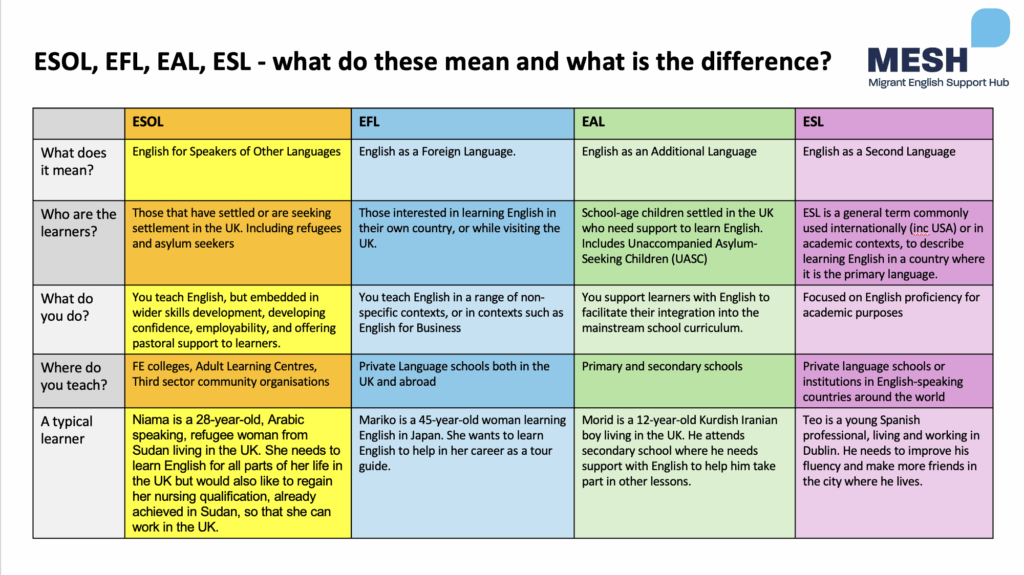Pathways into ESOL teaching
Not sure where to start or what qualifications you need to qualify as an ESOL teacher? The table below will give you an idea of the different levels of qualification available. The resource here is designed to help you understand the different pathways into ESOL teaching in the UK. The dynamic slides will help you to plot and understand the pathways you can take, on the basis of your existing qualifications and experience.

Getting Into ESOL
Find a course
Real Stories, Real Routes: Pathways to ESOL Teaching.
The pathways into ESOL teaching are diverse. People come into ESOL through a range of routes. In this section, you can watch videos and explore the journeys of a range of ESOL professionals.
Sumeera, Curriculum Team Leader at Rotherham College, shares her inspiring path into ESOL teaching. Sumeera talks about the value of lived experience, the power of education, and supporting learners at every stage.
The MESH team are all qualified ESOL teachers with classroom experience. In this film some members of the team talk together about the routes that brought them into ESOL. The discussion, led by Clare Jackson, demonstrates the varied pathways that lead to ESOL teaching.
What Does It Take to Become an ESOL Teacher?
In these two short interviews, we hear from leaders working across very different parts of the ESOL sector. Hayley Nelson is Director at Learn for Life, a community sector provider. Esther Derbyshire is Head of Adult, Community and ESOL at Leeds City College, one of the largest Further Education colleges in the region.
Both share clear, practical advice on how to get into ESOL teaching, from the qualifications you need to the kinds of experience that can make all the difference. Whether you’re thinking about volunteering, training, or applying for your first teaching role, their insights will help you understand what’s involved and where to begin.
ESOL and other forms of English learning.
One point that both ESOL managers speak about in the above interviews is the difference between ESOL and other forms of English teaching. It can be confusing as there are several different types of English learning – ESOL, EFL, EAL and others – delivered in different sectors with different target groups. The table below provides some guidance on the key differences.

The options for funded training to get into ESOL teaching are quite limited. These slides provide information on funding possibilities at different levels.
-
NATECLAVisit NATECLA
The National Association for Teaching English and Community Languages to Adults (NATECLA) is the professional association that represents ESOL practitioners and advocates for ESOL learning across the UK. NATECLA have an informative page on ESOL teacher training qualifications.
-
NATECLA ScotlandVisit NATECLA Scotland
NATECLA have branches across the country. The Scottish branch of NATECLA has some great resources on getting into teaching ESOL, including sections on identifying training needs, tips on lesson observations and teacher training top tips. Really useful and not just if you live or want to work in Scotland!
-
Language IssuesBrowse Language Issues
To get an idea of the kind of themes that are current in the ESOL field, take a look at Language Issues. This is the sector’s journal, run by NATECLA. It explores the area between academic research and classroom practice, discussing teaching, training, management and research into ESOL and community languages.
Find a course
 Search Training Courses
Search Training Courses


